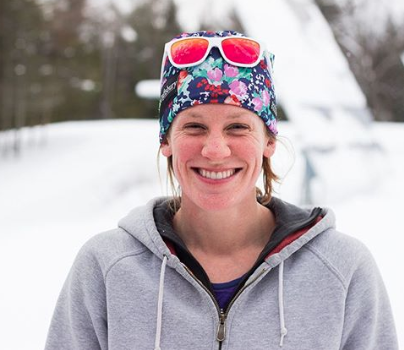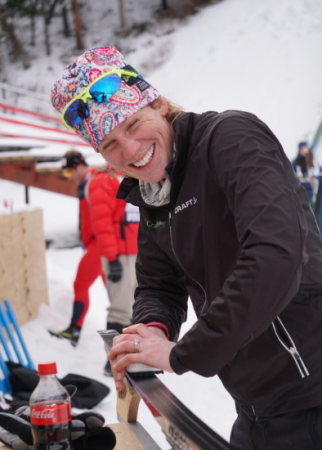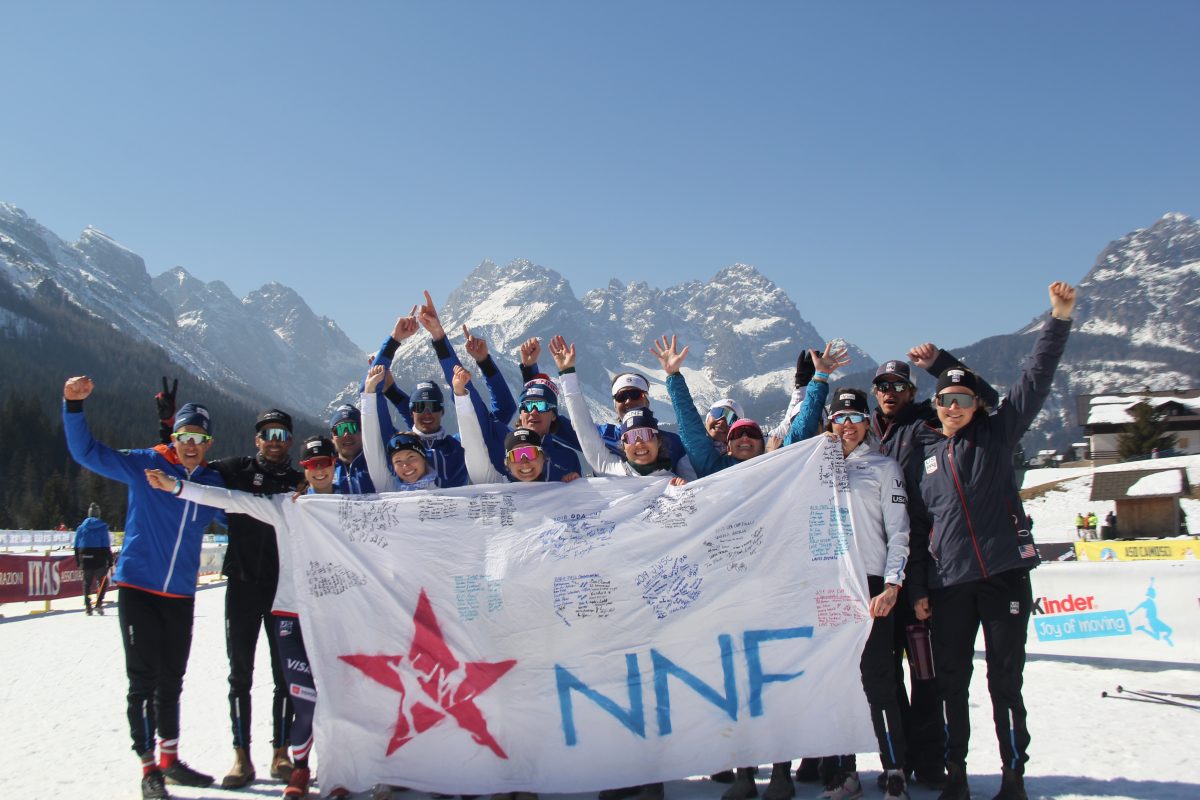Deciding how to handle the “college conflict”, as aptly phrased by Alayna Sonnesyn, is a daunting and somewhat mysterious prospect, particularly for athletes and families who are unfamiliar with the process. How does a junior athlete know that they are cut out for a collegiate program? NCAA or USCSA? What about a gap year? In this series, FasterSkier spoke with collegiate and junior coaches and athletes who have chosen different pathways to create a resource for the athlete or parent amidst this conundrum. In Part 1 of this series, FasterSkier spoke with Anna Schulz, Head Junior Coach at Craftsbury, about the evolution of the college process during high school, from the early athlete-coach conversations through setting collegiate race goals.

A native of the area and alumn of Pepa Miloucheva’s junior program at Craftsbury, Anna Schulz is entering her fifth year as the head junior and Bill Koch League (BKL) coach at the Outdoor Center. Before returning, the 32-year-old Harvard grad spent two years coaching in Bend, OR, then worked with the Mansfield Nordic BKL while earning a master’s degree in public administration at the University of Vermont. Schulz was the 2018 recipient of the NENSA Bill Koch League Leadership Award and attended the 2019 Junior World Championships as a member of the wax team.
While much of her insight comes from her time developing as a junior athlete, racing collegiately, and working with young athletes predominantly in the Northeast, her recommendations are relevant to juniors nationwide who are interested in training and competing after high school.
At Craftsbury, the discussion of whether an athlete has aspirations for collegiate ski racing begins as early as their freshman year of high school.
“Every spring, we have all of the high-school-aged kids fill out a goals form for skiing,” explained Schulz in a call. “Some of the questions are really specific — performance and results goals for the upcoming season — and then there are some that are long term. Do you want to try to ski in college? Do you just want to have it as a life-long sport? So we get an inkling as coaches starting in their freshman or sophomore year.”
As the athlete progresses through high school, the questions increase in frequency and specificity in order to keep track of where they stand in the college process.
“When they’re juniors, we start to ask them a lot more questions about what they’re thinking about and what their goals are. We put together a big info packet for our program that’s essentially everything we know about skiing in college. Part of it is a timeline for the kids’ junior year.”
This timeline includes recommendations on when to take the SAT or ACT, when to begin working on the college essay, and when an athlete should expect to be hearing from potential schools — September 1st of their junior year, per the NCAA rulebook. A robust database of the NCAA and USCSA programs nationwide is also included, along with contact information for the respective coaches, noteworthy team results, and information on training facilities and snow access for each program. [FasterSkier is working on crafting a generalized version of this document which will be shared at a later date.]
Schulz explained that she meets with each of her athletes to narrow this list based on which programs best suit an athlete’s needs and goals.
“We try to talk to the kids individually about it, so if we know that skiing is definitely their priority and they don’t care as much about academics they just want to go to a really competitive school for skiing, we’ll recommend, ‘Maybe you should look at these schools.’ And if they’re really excited about academics and maybe their skiing is not super strong or they’re not sure that they want to ski in college, we definitely talk to them about USCSA.”
She continued that not many of her racers so far have expressed interest in pursuing a post-graduate program or gap year.
Once a subset of potential schools has been identified, Schulz recommends that athletes begin scheduling unofficial visits during the spring of their junior year and the subsequent summer. While evaluating the opportunity to develop as a skier in a particular program is inevitably one of the focuses of these visits, Schulz encourages her athletes to widen their lens to ensure the school is a good fit beyond its athletic offerings.
“One thing we try to push them on is, ‘If you were not skiing, would you still like it there? Would you be happy where you are?’ Because kids often go to college and they decide that they don’t want to ski because there’s so much other cool stuff to do, or they get injured, or whatever it might be.”
She also encourages athletes to meet with coaches and to arrange an overnight stay or meet up with one of the athletes on the team to get a feel for what the environment is like. Athletes can also take advantage of coaches and older peers from their program who may have attended a school of their interest.
“We are pretty lucky at Craftsbury in that we have the Green Racing Project skiers here. A lot of them are fairly recently out of college, and between our coaching staff and the GRP, we have a whole smattering of college represented. So the kids can talk to someone who went to Williams or Bowdoin or UVM. There are a lot of representatives here to answer questions and I think that really helps them get a sense of what it might be like.”
One of the most important aspects of the process that Schulz discusses with athletes and families is the financial aid available at different programs. She believes there are a lot of misconceptions in regard to athletic, merit, and need-based scholarship and recalls not understanding this herself until her older brother went through it.
“Kids will routinely say, ‘I could never go to Harvard or Dartmouth because I can’t afford it.’ So learning about need-based financial aid is hugely important for some families. Some families will say, ‘Oh, my kid is super fast at skiing. They’re probably going to get a scholarship.’ And then they learn that Ivy League and NESCAC schools don’t offer athletic scholarships and that’s kind of a blow to them. So just trying to talk to families about the money piece is really important.”
She continued that many families are also misinformed about how much or little results at Junior Nationals can have on admissions.
“You can be super fast at skiing, but if you don’t have very good grades or test scores, there’s only so much that coaches can do to help you get in. I think there’s a lot of misperceptions around how recruiting and admissions work.”
Information regarding GPA and SAT/ACT requirements can be found on most schools’ websites. Schulz recommended a Google search to look at averages and minimums.
Apart from selecting a school, Schulz also talks with her athletes about the changes they will experience as they transition into a college program.
“The conversations vary a lot depending on where they want to go to school. Especially coming from rural Vermont, if a kid is looking at Harvard, it’s going to be really different and training is going to be really different. So we help them envision what training might look like as far as the physical environment. Are you going to be able to ski from campus? Are you going to have nice trails? Does that matter? What is the rollerskiing going to be like? Trying to get into their heads what the day-to-day training might be like.”
Apart from training, leaving the home and adjusting to newfound independence can be a challenge for some athletes. With the college experience comes increased social and academic pressure as well as new demands on their time. Schulz explained that these issues are also part of the dialogue on the junior race team, but they are less straight forward than setting a date for the SAT.
“I don’t think there is a real template for that. Some kids are so anxious for that independence and some kids would just stay at home and we’re more pushing them toward going somewhere farther away and out of their comfort zone.”
In most cases, skiers miss a lot of class time in the winter. Races typically fall between Friday and Sunday, but with travel, athletes may miss additional class time. Coupled with the increased rigor of collegiate academics, staying afloat can be difficult if an athlete is not prepared. Schultz added that she has not seen the adjustment to keeping up academically as an obstacle for most of her racers.
“A lot of the kids that we coach here are pretty well prepared for a lot of the demands on their time in college because they mostly go to public schools, so there’s not really a whole lot of concessions in their schedule to work around ski training. Which is one kind of weird advantage that public school kids have over ski academy kids as far as knowing how to juggle their time and talking with their teachers about a class they’re going to miss and having to figure out some of that stuff on their own.”
She added that the learning curve has been steeper for her skiers that have attended Craftsbury Academy, which she referred to as a “quasi ski academy” as it enables students to adjust their class schedule to better accommodate their training and racing.
During the school selection process, Schulz also discusses setting performance goals for the collegiate race field. Depending on the school, an athlete might expect to race among the top skiers right away, while others might need to focus on developing as an athlete for a few more years before making the race team.
“It’s about being pretty honest with them and I think it’s pretty important to have those conversations with them. To say, ‘Hey, it’s cool that you’re really excited about Dartmouth, but just so you know, this is about where you’re probably going to stack up on the team. That means you would go to these open Carnivals but probably you’ll be skiing Eastern Cups with the development team.’”
If possible, Schulz recommends an athlete race in a field with collegiate skiers to determine where they stack up so they can set realistic performance goals once they have joined a team.

“The East is really lucky to have all of these big races that have college skiers and juniors. Whether its a SuperTour or an Eastern Cup that gets combined with a Carnival, there are multiple times every year where the high school kids are skiing against the college kids. They can kind of get a sense, too, of, ‘Oh. I just beat all of the Bowdoin boys except for their top guy, so maybe I would make the Carnival team there.’ That’s been a really useful tool.”
After an athlete leaves her program, Schulz leaves her skiers’ training up to their respective new coaches, however, she has increasingly worked with her athletes during the summer.
“We’re just getting to the point of having a bunch of kids now who we worked with as juniors who have gone off to college. A lot of them are back around for the summer, so we have a little college summer training group.”
Unless the athlete has a predetermined plan for summer, Schulz resumes writing their plan so they can plug into the rest of the training happening at Craftsbury.
“It’s really dependent on their college programs and their college coaches, but for the most part in the summertime, their college coaches are saying, ‘Go train with your club and do whatever they’re doing. If you have a strong training group, that’s great. That’s super important.’ So we have a couple of Middlebury and Dartmouth girls, a UVM skier, a St. Lawrence skier who are all around for the summer and we were writing their training plans and they would float between doing workouts with the juniors and with the GRP.”
When the athlete heads back to school, Schulz hands the reigns back to the college coach but updates them with insight into the athlete’s progress that summer.
“Some of the coaches I communicate with fairly often, even if it’s just saying, ‘Hey. So-and-so was training a lot this summer and was looking pretty tired.’ Or, ‘Just so you know, this person got a concussion.’ So some of the coaches we’re in touch with a lot, and others I’ve barely ever emailed with. I try to just let them go and only keep tabs on them if needed or if they reach out and say, ‘Hey, I’m having a hard time. Can you give me some advice?’”
This series will continue with an interview with Cami Thompson-Graves, head coach at Dartmouth College, who will share insight into the college visit and the collegiate coach perspective on the recruiting and admission process.
Rachel Perkins
Rachel is an endurance sport enthusiast based in the Roaring Fork Valley of Colorado. You can find her cruising around on skinny skis, running in the mountains with her pup, or chasing her toddler (born Oct. 2018). Instagram: @bachrunner4646



